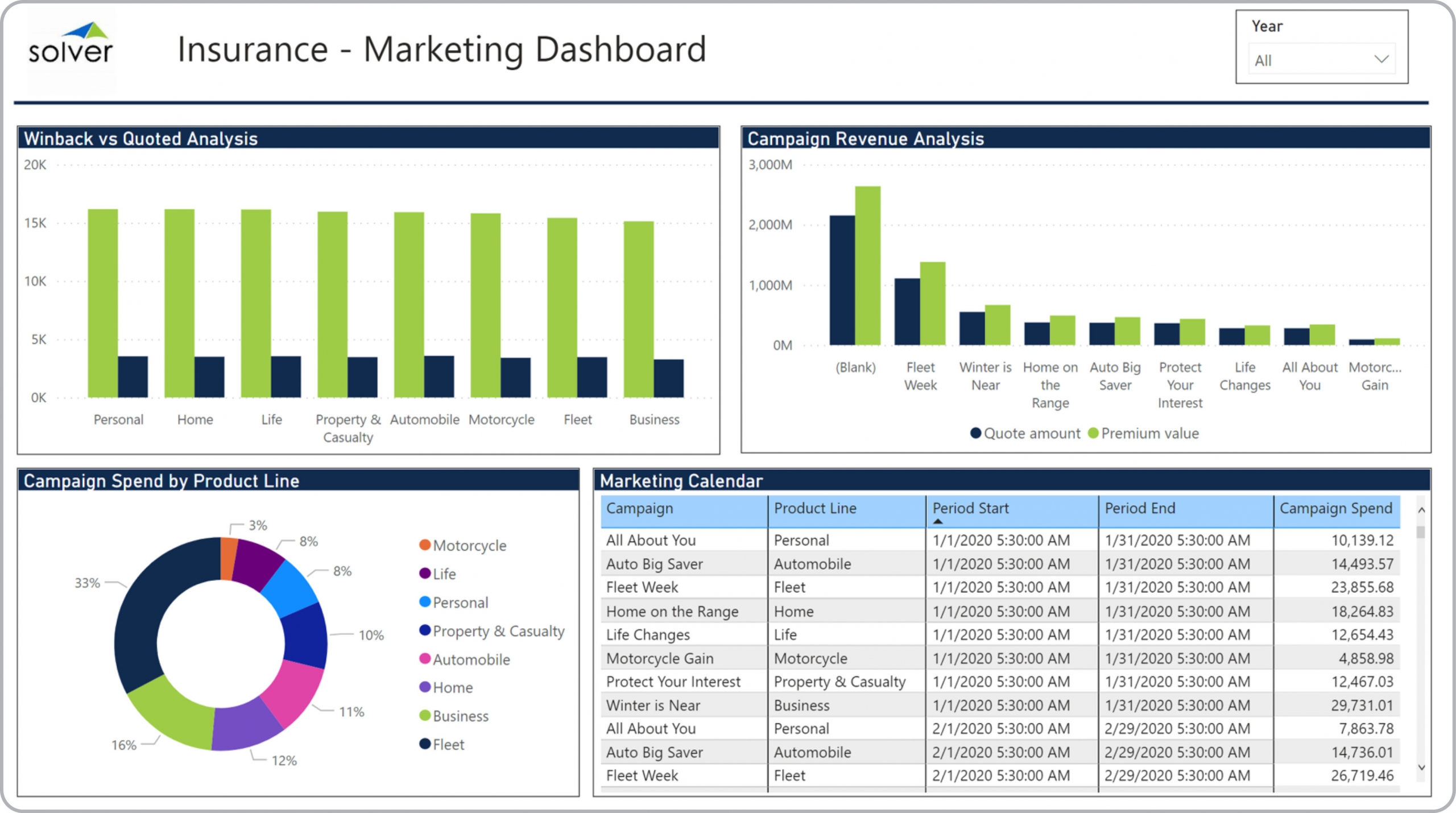Marketing Dashboard for Insurance Companies
What is a
Marketing Dashboard
? Marketing Dashboards are considered operational analysis tools and are used by Marketing and Sales Managers to analyze lead-generating activities that grow the sales funnel. Some of the main functionality in this type of dashboard is that it enables analysis of marketing activities from four different perspectives: 1) Winback versus quoted analysis by product line, 2) Revenue analysis by Campaign, 3) Campaign spend by product line, and 4) Marketing calendar information and related campaign spend. You find an example of this type of dashboard below.
Purpose of
Marketing Dashboards Insurance companies use Marketing Dashboards to give managers a clear picture of how well (or not) their marketing activities are working. When used as part of good business practices in Marketing and Financial Planning & Analysis (FP&A) departments, an organization can improve its campaign results and increase revenues, and it can reduce the chances that managers execute campaigns with a poor return on investment (ROI).
Example of a
Marketing Dashboard Here is an example of a Marketing Dashboard with win-back and campaign metrics. [caption id="" align="alignnone" width="2560"]
 Example of a Marketing Dashboard for Insurance Companies[/caption] You can find hundreds of additional examples
here
Who Uses This Type of
Dashboard
? The typical users of this type of dashboard are: Marketing Executives, Sales Managers.
Other Reports Often Used in Conjunction with
Marketing Dashboards Progressive Marketing departments sometimes use several different Marketing Dashboards, along with detailed marketing reports, sales funnel reports, sales dashboards, marketing expense budgets, sales forecasts and other management and control tools.
Where Does the Data for Analysis Originate From? The Actual (historical transactions) data typically comes from CRM systems and enterprise resource planning (ERP) systems like: Microsoft Dynamics 365 (D365) Finance, Microsoft Dynamics 365 Business Central (D365 BC), Microsoft Dynamics AX, Microsoft Dynamics NAV, Microsoft Dynamics GP, Microsoft Dynamics SL, Sage Intacct, Sage 100, Sage 300, Sage 500, Sage X3, SAP Business One, SAP ByDesign, Acumatica, Netsuite and others. In analyses where budgets or forecasts are used, the planning data most often originates from in-house Excel spreadsheet models or from professional corporate performance management (CPM/EPM) solutions.
What Tools are Typically used for Reporting, Planning and Dashboards? Examples of business software used with the data and ERPs mentioned above are:
Example of a Marketing Dashboard for Insurance Companies[/caption] You can find hundreds of additional examples
here
Who Uses This Type of
Dashboard
? The typical users of this type of dashboard are: Marketing Executives, Sales Managers.
Other Reports Often Used in Conjunction with
Marketing Dashboards Progressive Marketing departments sometimes use several different Marketing Dashboards, along with detailed marketing reports, sales funnel reports, sales dashboards, marketing expense budgets, sales forecasts and other management and control tools.
Where Does the Data for Analysis Originate From? The Actual (historical transactions) data typically comes from CRM systems and enterprise resource planning (ERP) systems like: Microsoft Dynamics 365 (D365) Finance, Microsoft Dynamics 365 Business Central (D365 BC), Microsoft Dynamics AX, Microsoft Dynamics NAV, Microsoft Dynamics GP, Microsoft Dynamics SL, Sage Intacct, Sage 100, Sage 300, Sage 500, Sage X3, SAP Business One, SAP ByDesign, Acumatica, Netsuite and others. In analyses where budgets or forecasts are used, the planning data most often originates from in-house Excel spreadsheet models or from professional corporate performance management (CPM/EPM) solutions.
What Tools are Typically used for Reporting, Planning and Dashboards? Examples of business software used with the data and ERPs mentioned above are:
- Native ERP report writers and query tools
- Spreadsheets (for example Microsoft Excel)
- Corporate Performance Management (CPM) tools (for example Solver)
- Dashboards (for example Microsoft Power BI and Tableau)
Corporate Performance Management (CPM) Cloud Solutions and More Examples
May 19, 2021
TAGS:
Reporting,
Solver,
insurance,
report writer,
Microsoft,
template,
practice,
Acumatica,
Netsuite,
Finance,
planning,
GP,
dashboard,
fintech,
Business Central,
excel,
ax,
forecast,
Budget,
Dynamics 365,
analysis,
budgeting,
KPI,
Cloud,
Software,
Tableau,
SAP,
example,
best,
Sage,
BC,
D365,
NAV,
Intacct,
CPM,
report,
SL,
Management,
dynamics,
Power BI,
marketing dashboard,
insurance dashboard,
quoted,
campaign spend,
campaign revenue

